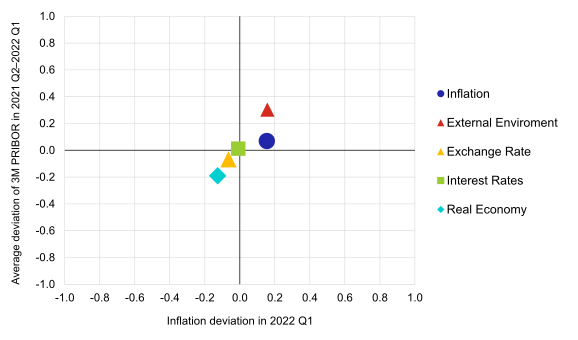Graph of Risks to the Inflation Projection (GRIP)
2nd Situation Report 2021
The forecast in Monetary Policy Report – Winter 2021 was prepared in an environment of extraordinary risks and uncertainties stemming mainly from the government’s anti-epidemic measures and the related economic impacts due to the ongoing coronavirus pandemic. Unprecedented uncertainty persists, continuing to affect both economic life itself and the way it is captured by the statistical data. In view of this, it can be said that the current forecast is materialising relatively well so far.
In the updated external outlook, higher industrial producer price inflation and marginally higher interest rates in the GRIP simulation foster slightly higher levels of both domestic interest rates and inflation. As regards domestic factors, a slighter-than-expected slowdown in consumer price inflation in January and February acts in the same direction. However, these factors are partially offset by a worse epidemic situation so far this year, which leads to an anti-inflationary effect of the real economy. This effect reflects the government’s longer and tighter anti-epidemic restrictions, which is taken into account in the GRIP simulation through a downward expert adjustment of household consumption in 2021 Q1. This factor outweighs the higher-than-expected wage growth at the end of last year and a shift in the expected fiscal impulse to slightly positive levels this year. A somewhat stronger exchange rate of the koruna in 2021 Q1 also fosters slightly lower interest rates and inflation. Overall, the balance of risks to the forecast captured in the GRIP simulation thus implies slightly higher levels of both interest rates and inflation compared with the current forecast.
The main risk outside the GRIP simulation is a slower fading out of the unfavourable epidemic situation, and thus slower opening of the domestic and European economies. This risk was described in the longer-lasting pandemic-induced downturn scenario in Monetary Policy Report – Winter 2021. Compared with the baseline scenario of the forecast, this scenario assumed – from 2021 Q2 onwards – a worse course of the pandemic both in the Czech Republic and the EU and related negative demand and supply impacts. The scenario led to a need to keep monetary conditions accommodative for longer than in the baseline scenario. The very unfavourable course of the coronavirus pandemic in recent weeks, including the sluggish rollout of vaccination, confirms the relevance of this scenario, although its materialisation to the assumed extent cannot yet be confirmed. The drop in Czech automotive industry production recorded at the start of this year is also unfavourable news. On the other hand, domestic fiscal policy may be somewhat more expansionary this year than assumed in the GRIP simulation so far.
After taking these facts into account, the Monetary Department assesses the uncertainties and risks of the forecast in Monetary Policy Report – Winter 2021 in the context of the ongoing pandemic as remaining very substantial but broadly balanced overall.
